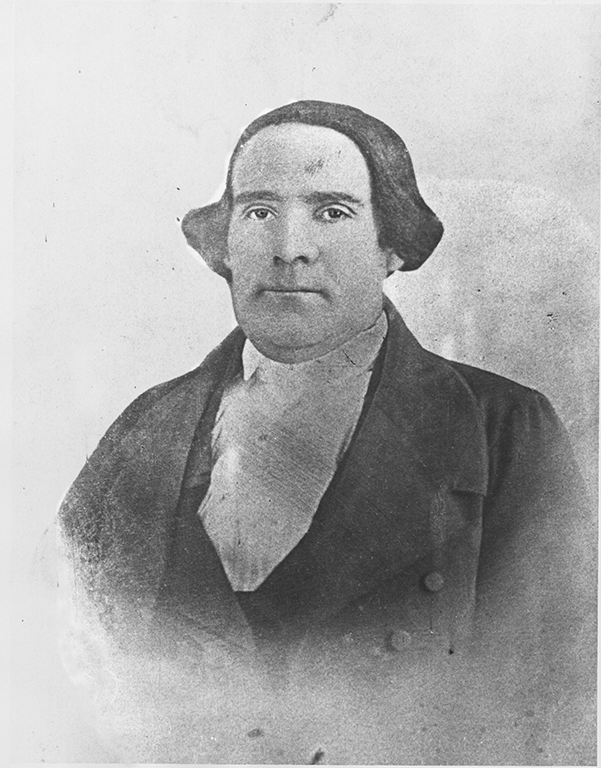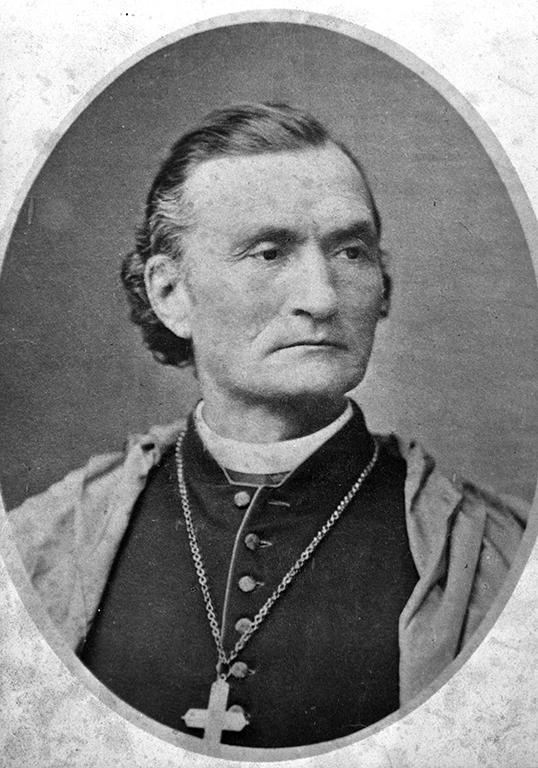Nuevomexicano officials realized that their province faced myriad difficulties because of the forces pulling it in various directions. On the eve of the U.S.-Mexico War, the government in Santa Fe was confronted with the problems of how to deal with fiscal shortfalls, how to negotiate the political morass in central Mexico, and, most urgently, how to defend New Mexican settlements against the incursions of increasingly hostile native peoples. As these issues erupted into open conflicts, some prominent nuevomexicanos, such as Donaciano Vigil and Padre Antonio José Martínez, proved able to navigate the marked changes that accompanied Mexican independence, the rise of Comanche prominence, and American conquest. Vigil and Martínez were each dedicated to their people and their homeland, but they adapted and accommodated to change in vastly different ways.

Albright Art Parlors (photographer). Courtesy of Palace of the Governors Photo Archives (NMHM/DCA), No. 011405.
Both men began their lives at the end of Spanish colonial rule over New Mexico. Vigil was born in Santa Fe in 1802. He and his siblings were educated at home by their father, Juan Cristóbal Vigil. This education opened doors later in his life that might otherwise have been closed to him. As one merchant reported, Donaciano and his brother Juan were known as “among the best educated men in public life in the department.”8 At six feet, five inches tall and 220 pounds, Donaciano Vigil seemed destined to follow his father’s footsteps into a military career. Following Mexican independence, he enlisted in the Mexican army and by 1832 was promoted to sergeant in command of the San Miguel del Bado Company, stationed at Santa Fe. In that capacity, he gained a reputation as an effective campaigner against nomadic peoples.
Padre Martínez developed his sense of Mexican nationalism through his ecclesiastical training and mission. In contrast, Vigil’s sense of Mexican patriotism was forged through military service. Both men recognized that the Santa Fe Trade had transformed New Mexico’s economy at the price of intensifying conflicts with indigenous peoples. They separately commented on the deleterious impact of American traders and settlers. As Americans increasingly took control of trade away from nuevomexicanos, Vigil noted a corresponding decline in New Mexico’s political fortunes relative to natives. Santa Fe Traders exchanged weapons with Comanches and Apaches in order to work out their own peaceful passage along the overland trails. Those same horse peoples then used the weapons they had acquired in raids against New Mexican settlements. Due to traditional grazing and settlement practices, livestock seemed especially susceptible to raids.
Martínez and other contemporaries painted an equally grim picture of relations with indigenous peoples, but placed blame for increasing pillage squarely on the shoulders of American newcomers. The priest maintained the hope that the central government in Mexico City would help to address frontier conflicts with Apaches and Comanches. He also believed that government and regional programs to subdue nomadic peoples should focus on education in “civilized” lifeways in order to bring them out of “savagery.”
Undoubtedly, Martínez recognized that political and economic instability in central Mexico exacerbated New Mexico’s troubles, but his communications did not highlight such flaws as he hoped to inspire Mexican policymakers to sympathize with—and support—nuevomexicano relations with natives. Vigil, on the other hand, recognized the reality of the Mexican government’s indifference toward its northern frontier. In his communications to nuevomexicanos, Vigil emphasized the fact that little help was forthcoming from the national government. Also unlike Martínez, he believed that Comanches and Apaches could only be subdued through military campaigns. Rather than seeking funds for education or trade, then, Vigil petitioned weapons.
Although the Santa Fe Trade flooded New Mexico with new goods in the 1830s and early 1840s, many nuevomexicanos had access only to bows and arrows for defense against Comanche and Apache firearms. One of the reasons for the disparity was a Mexican law that prohibited the importation of foreign arms and ammunition—even along the Santa Fe Trail. Vigil wrote several petitions geared to persuade Mexican officials to lift the ban. The territorial legislature supported his reasoning and forwarded one such petition to the central government in early 1846, although it reached the capital too late to be of any good.
Like all human beings, Vigil was a man of seeming contradictions. Despite his well-documented campaign to condemn Governor Manuel Armijo for capitulating to Kearny’s Army of the West, Vigil counseled the governor not to lead forces against the Americans just prior to the occupation on June 18, 1846. While he never set aside his Mexican nationalism, Vigil’s actions were pragmatic. Perhaps better than other New Mexico officials, he understood his people’s disadvantage in terms of weapons and supplies. As he put it, how would their people defend the province against the Americans with only “quivers and slings?”9
As evidenced in his conflict with Bishop Jean Baptiste Lamy, Padre Martínez continued open resistance to American occupation until his death in 1867. Vigil, however, served in American-backed governments as early as 1846. It is easy to view him as an opportunist, but Chicano historians have recently reevaluated the legacy of Donaciano Vigil. Instead of seeing a man concerned only with the well-being of himself and his family, historians such as Robert J. Rosenbaum and Carlos R. Herrera argue that he consciously maintained a position of prominence in the U.S. regime in order to leverage his influence in favor of his people and their culture.

William Henry Brown (photographer). Courtesy of Palace of the Governors Photo Archives (NMHM/DCA), No. 009970.
Vigil served as interim governor, territorial governor, and territorial secretary after Kearny’s army took possession of New Mexico. In later years, the Vigil family acquired lands and resources almost as extensively as Thomas B. Catron—a figure labeled as a land grabber by contemporaries and historians alike. As a member of the nuevomexicano rico class, Vigil fully recognized the importance of wealth and its concomitant political influence in order to preserve the history, language, and rights of a conquered people. According to Rosenbaum, such accommodations to U.S. conventions were a form of resistance because Vigil understood the futility of armed struggle. By coming to terms with the American conquest of New Mexico and serving in prominent positions, Vigil was poised to promote programs for increased literacy and cultural preservation.
Padre Martínez and Donaciano Vigil both worked tirelessly to promote New Mexico’s place in the Mexican nation during their earlier years. Both men published newspapers, advocated for enhanced educational programs for all, and viewed the danger of increasing American economic influence. They differed in terms of their views on native peoples’ capacity to become civilized—neither was able to consider Comanches, Apaches, Navajos, or Utes on their own terms. Following the U.S. conquest of the Southwest, Padre Martínez used his position to resist the Americanization of nuevomexicano Catholicism, while Vigil integrated himself into the U.S. economic and political regime. The significance of their actions has been, and will continue to be, a point of debate for scholars of the Mexican period.